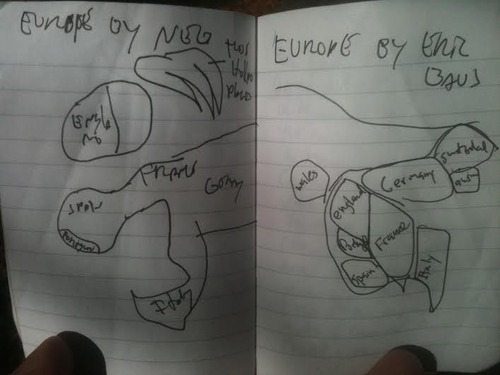
From “Draw Europe”
Inside of this month’s art issue, we’ve commissioned a series of event scores called “Some Instructions” from a variety of our favorite artists, writers, and musicians. These event scores are performances open to your interpretation. You’re urged to perform these instructions privately, publicly, or “negatively” (i.e., not at all). You can decide to simply read the instructions—alone, in front of your cat, or before a stadium full of spectators. You can float these instructions on the surface of a nearby lake. You can post your performance to YouTube and tag it “skywalkers gangnam style star wars lego.” The choice is yours. You’re the artist.
Here are five event scores from Noah Eli Gordon:
“Covers”
Go to a club that caters to local talent, one of the singer-songwriter variety. Find a relatively unknown act, say a man half your age with an easy voice and a propensity for minor chords. Surreptitiously record him playing. Learn these songs; this might takes weeks, but be sure you’ve perfected them. Contact the man, tell him you’d seen him play, and would love to do a show together, would love, in fact, to open for him. Play only this man’s songs at the show. Say nothing about it. Have someone in the club video this man’s face while you’re playing his songs. Make a loop of this video, a silent one. Title the piece “Covers.”
“Erasure”
Install in the center of a small gallery a medium-sized cherry tree. When your exhibition opens, begin by plucking each leaf. Speak to no one. Move slowly, methodically, and be sure to dress in neutral, yet drab colors. Something wool or linen. Once the tree is thoroughly leafless, remove the square of sandpaper from your pocket. The exhibition is to close once you’ve sanded the entire tree to nothing.
“Artists on Painting”
Survey strangers in a high traffic area—your only question: What is painting? Save these answers. Record them. Later, you’re going to turn them into paintings. To do this, transcribe with a black marker each answer onto canvas stretched especially to fit the answer’s entire text. This may take some practice, but you’re learning. You’re learning. Assemble two dozen of these works for a gallery show. Title the show, “Artists on Painting.” Make a list of twenty four famous artists. It’s best if they’re contemporary; failing that, at least those who’ve produce work within the last fifty years, those whose lexical tics wouldn’t be so alien so as to exclude whatever contemporaneous flourishes (or restraints) you’d discovered in interviewing the public. Wait, I’ll do it for you: Alice Neel, Andy Warhol, Jasper Johns…oh, never mind, just make sure you attribute each quotation you’ve...
You have reached your article limit
Sign up for a digital subscription and continue reading all new issues, plus our entire archives, for just $1.50/month.
Already a subscriber? Sign in




